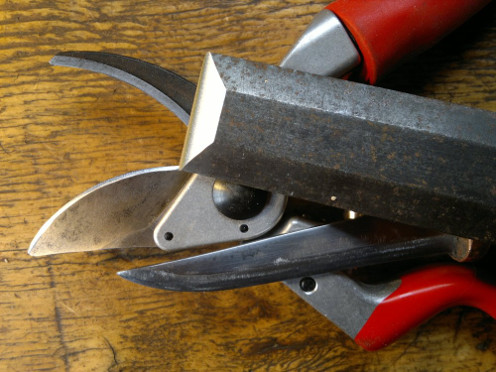Sharpening edge tools

I offer a hand tool sharpening service that covers most common items:
knives, scissors, shears, secateurs, loppers, axes, billhooks, slashers, etc.
Carpentry tools: chisels, gouges (in cannel and out), plane irons, drawknives, spokeshaves etc.
Spiral auger bits (Jennings, Irwin, Gedge) are often sharpenable, if not too abused, as are flat bits for power drills, and hex shank spiral auger bits for electric drills.
I am able to sharpen rotary mower blades (e.g. Hayter, Flymo) and brush cutter blades but NOT cylinder mower blades.
To arrange tool sharpening contact me.
Prices are from £4 per item (e.g. most knives). Very abused/damaged/pitted items will cost more, as do very hard metal alloys. It is rare for any single sharpening job to cost over £12.
If you want to tackle your own sharpening I have the following thoughts.
If there is one tool related subject that causes most confusion it is sharpening. I suspect that for the average user a bit of theoretical knowledge might help to remove the mystery a little. That in turn should help with deciding how to practically tackle a sharpening "problem".
Almost all* edge tools are sharpened by removing metal from the area immediately behind their edge, on their bevels. This has the effect of leaving the edge itself thinned down to such an extent that it will enter substances easily and therefor cut them.
The edge also has to be strong enough that it won't buckle in use when it encounters a particularly firm area of the item to be cut, or when the tool suddenly hits a material, as with a striking type cutting tool e.g. an axe.
This requirement for penetrating thinness and robust strength results in the need for a fine edge backed up by a profile that gives adequate strength and allows the tool to do its intended job: perhaps like the curved shape of a rocket nose cone for an axe; or thin, parallel blade faces with an abruptly starting (but acute) taper for a scalpel blade; a chisel needs to be sharpened on one face only, the bevel having a profile like a ramp, often steepest just before the edge (the other side being completely flat, with no hint of a bevel).

If you have this in mind, you can assess if you need to remove a lot of metal behind the edge to get a profile that will allow the sharp edge to do its job - a very fine sharp edge backed up by fat wedge of metal just won't penetrate the item you are trying to cut. On the other hand a very fine acute taper to an edge won't do on a felling axe for use on hard woods, as the edge will break. Experience and judgement are needed to to get cutting tool profiles correct, so patience and experimentation are needed while you learn.
Assuming that you know the type of profile you need, the mechanics of sharpening are relatively straightforward. You use your patience and your preferred abrasives (progressing from coarse grades to fine) to remove metal until the desired shape is formed, at the same time not overheating ("blueing") the metal, and not damaging yourself (i.e. use eye protection, respiratory protection, cut protection as appropriate). As far as the actual edge itself goes, when the bevels meet with a burr, or fine fringe, or "wire edge" of flexible metal you are nearly finished, you just need to gently remove that burr without crushing it into the edge: a good method is to strop it on leather repeatedly from both sides, perhaps adding a little metal polish to the leather's surface. This will give a clean, robust and truly sharp edge.
... or get a copy of Sharp by Sean Hellman - a truly comprehensive book on sharpening all sorts of tools.
*European scythes are partially sharpened by peening to thin the edge.
To enquire about tool repairs contact me.
© Ian Swain 2021